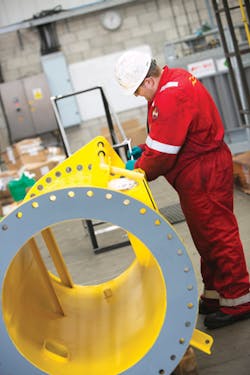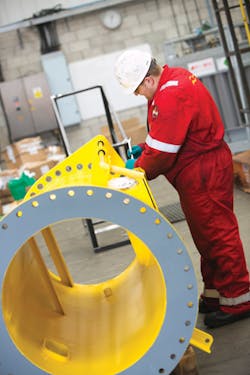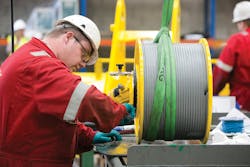Crane adapted for deeper water wind farms
Stuart Smith, Sparrows Group
Near-shore windfarms are traditionally located in water depths of up to 30 m (98 ft), with mono-pile foundations mounted to the seabed. Typically, standard davit cranes with short fixed booms are deployed from these installations to lift and lower materials from supply vessels. However, as wind farms move into deeper waters, the foundation changes to a lattice or jacket with a wider footprint, increasing the crane’s radius requirements in order to reach the supply vessel. This in turn creates a need for a more traditional offshore-type crane with greater functionality.
Sparrows Group has devised a new lifting solution, the WindMaster crane, to accommodate the larger structures in deeper waters. It employs an 8-m (26-ft) boom with full powered slewing, luffing and hoisting functions that allow it to access decks of supply vessels even in higher sea states. Recently the company signed a contract to supply 103 WindMaster cranes for installation at ScottishPower Renewables’ 714-MW East Anglia ONE wind farm off the Suffolk coast in southeast England. This is due to generate first power later in the year and should be fully operational by 2020. A crane will be installed on each of the farm’s 102 wind turbines with a further crane used for training purposes.
WindMaster crane under development. (All Images courtesy Sparrows Group)
Strength assessment
All cranes have a deflection rate – an ability to flex so that they can absorb the loading forces that come from lifting a heavy weight in a dynamic situation – and accuracy was critical in order to reduce the load impact of the new design. Ropes provide most of the required deflection due to their flexibility: one of the main challenges was to optimize the hoist ropes to ensure sufficient strength to comply with minimum safety requirements but at the same time not to the extent that they became too rigid, as this which would increase the dynamic forces that affect the specification of all the other crane components.
Hydraulic apprentice under supervision.
Unmanned wind turbines require regular maintenance and a robust protection system is a must to prevent corrosion. Cranes on offshore turbines are generally 15-25 m (49-82 ft) from the water line: as steel naturally corrodes in this environment, alternative materials were adopted where possible for the new design such as nylons, GRP and stainless steels. A protective paint system was applied with care taken to avoid potential contact with or chipping of the coating that might degrade the corrosion resistance. For areas of the crane where stainless steel and general carbon steel are in contact, an insulator was applied to limit the impact of accelerated galvanic corrosion that can often occur between these materials.
Due to a lack of regular accessibility once deployed in-field (since the turbines are unmanned), reliability of the crane would be critical. To eliminate the chance of water ingress and material deterioration a PTFE coating protection was applied on steel components in combination with a marine sealant. For pinned connections, a two-part xylan coating was adopted consisting of a xylar hard bonding agent with a xylan PTFE coating on top, which insulates the material. Nylon was used for the crane sheaves and spacers inserted between any moving components to provide wear protection.
Sparrows has transferred its knowledge from years of experience in the offshore oil and gas industry for the new offshore crane. As the renewables sector continues to expand and evolve, new challenges will emerge, and the supply chain must be prepared to adapt and meet those needs. •
the Author
Stuart Smith is head of design and technology at Sparrows Group.



